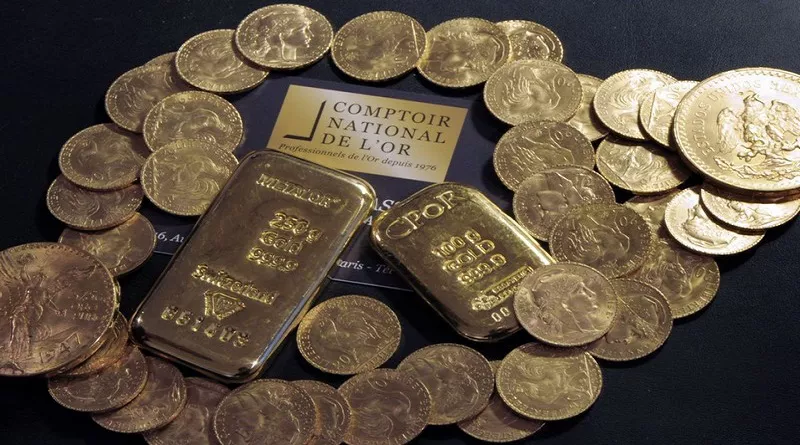Gold continues its remarkable 2025 rally, climbing nearly 28% year-to-date as it rebounds from a modest correction tied to China’s extended Labour Day holiday. The yellow metal has firmly reasserted its safe-haven status, drawing strength from strong Chinese demand, resilient inflation, and mounting global macroeconomic uncertainty.
China Anchors Global Gold Demand
China remains the standout driver behind gold’s surge. Retail and institutional demand in the country has accelerated sharply, with local gold-backed ETFs surpassing their 2024 inflow totals by mid-year. A pre-holiday spike in domestic premiums over international spot prices reflects persistent appetite — largely driven by a mix of economic caution, weak equity performance, and currency devaluation concerns.
Adding fuel to the rally, Chinese central bank purchases continue to grow, reinforcing the broader global trend of central banks diversifying away from U.S. dollar holdings. This dynamic shows no signs of slowing, particularly as geopolitical tensions remain high.
Technical Recovery from May Correction
After a brief dip toward USD 3,200, gold found support above USD 3,160–3,170, rallying back to reach USD 3,387 during the Asian session — re-establishing bullish momentum. Interestingly, this recovery has been led by non-pit trading hours, while U.S. “pit” hours (08:20–13:30 EST) have seen more muted activity.
Speculative flows from hedge funds and CTAs (Commodity Trading Advisors) have shifted, with net long futures positions hitting a 14-month low of 11.6 million ounces as of May 29 — a 55% drop from September 2024, when gold traded at USD 2,650. While leveraged funds have pulled back, Asian investors have taken the reins, particularly in the physical and ETF markets.
Market Consolidation After Reaching USD 3,500 Target
With gold already touching the 2025 price target of USD 3,500, the market appears to be entering a wait-and-see phase. Nonetheless, several core structural drivers suggest a continued upside bias:
- Fed rate cut expectations: The futures market is pricing in a potential 75–100 basis points of rate cuts by year-end.
- Declining real yields: Inflation-adjusted bond yields continue to fall, increasing gold’s relative appeal.
- Persistent inflation: Elevated consumer prices remain a key theme in both developed and emerging markets.
- Central bank diversification: Over 1,000 tons of annual central bank purchases since 2021 continues in 2025.
Silver Trails Gold Amid Cyclical Pressure
Silver remains subdued relative to gold, with the XAUXAG ratio above 100, a sign of underperformance. While gold benefits from institutional and reserve demand, silver’s semi-industrial nature leaves it exposed to economic slowdowns, particularly in China’s solar sector, which is experiencing a glut in supply and reduced growth.
Despite this, technical levels suggest silver may be close to a rebound. The recent dip below USD 32 found support at USD 31.63 — the 0.382 Fibonacci retracement of its latest 19% rally. To the upside, USD 33.35 and USD 33.68 (a triple top formation) represent key resistance points. If breached, silver could move rapidly — consistent with its historic tendency to mirror gold’s moves with higher volatility.
Platinum Flatlines in Tight Range
Platinum continues to underwhelm, remaining near its long-term average of USD 955 and well below gold’s relative outperformance. The platinum-gold ratio now stands at 3.5-to-1, near historic extremes. The metal has spent much of the past decade trading sideways, and while traders await a breakout, momentum remains scarce.
Key levels to watch include USD 1,010 and a long-term downtrend line around USD 1,025, drawn from the 2008 highs. A break above these could re-ignite speculative interest, but for now, positioning remains neutral across managed money accounts.
Key Structural Drivers Supporting Gold’s Rally
A combination of macroeconomic and geopolitical forces continues to underpin gold’s ascent:
1. U.S. Federal Reserve Rate Expectations
- Markets are anticipating a dovish policy pivot, with up to 100 basis points in rate cuts priced in for 2025.
- Lower rates reduce the opportunity cost of holding non-yielding assets like gold, enhancing its value proposition.
2. Inflation and Real Yields
- Rising inflation expectations and falling real yields across the Treasury curve are decreasing the appeal of traditional fixed-income assets.
- Gold acts as an inflation hedge, driving investor allocation amid persistent price pressures.
3. Central Bank Demand
- Nations including China, India, Russia, and Turkey continue to build gold reserves to reduce reliance on the U.S. dollar.
- Central bank gold purchases have exceeded 1,000 tons annually for three consecutive years — a record pace.
4. Geopolitical Risks
- From the ongoing U.S.–China trade war to escalating military conflicts, rising global tension keeps gold demand elevated.
- Recent correlations between defense stocks and gold confirm the market’s shifting focus toward geopolitical risk hedging.
5. Asian Retail and Institutional Demand
- With weak Chinese equities, falling property prices, and renminbi depreciation fears, domestic investors in China are piling into gold as a capital preservation strategy.
- Gold-backed ETFs in China have already exceeded 2024 inflows, signaling robust underlying demand.
Conclusion
With gold already reaching key price milestones and silver positioned near a potential breakout, the market stands at a critical juncture heading into the second half of 2025. The convergence of monetary easing, rising inflation, and renewed trade risks is likely to sustain momentum in precious metals.
While speculative positioning remains light, strong structural demand from central banks and Asian investors provides a durable floor. If global conditions deteriorate further — particularly with tariff escalation or Fed policy shifts — gold could extend well beyond USD 3,500, while silver may catch up rapidly, reclaiming its historic ratios.
In a world defined by volatility and shifting global power structures, gold remains not just a hedge — but a strategic asset.


